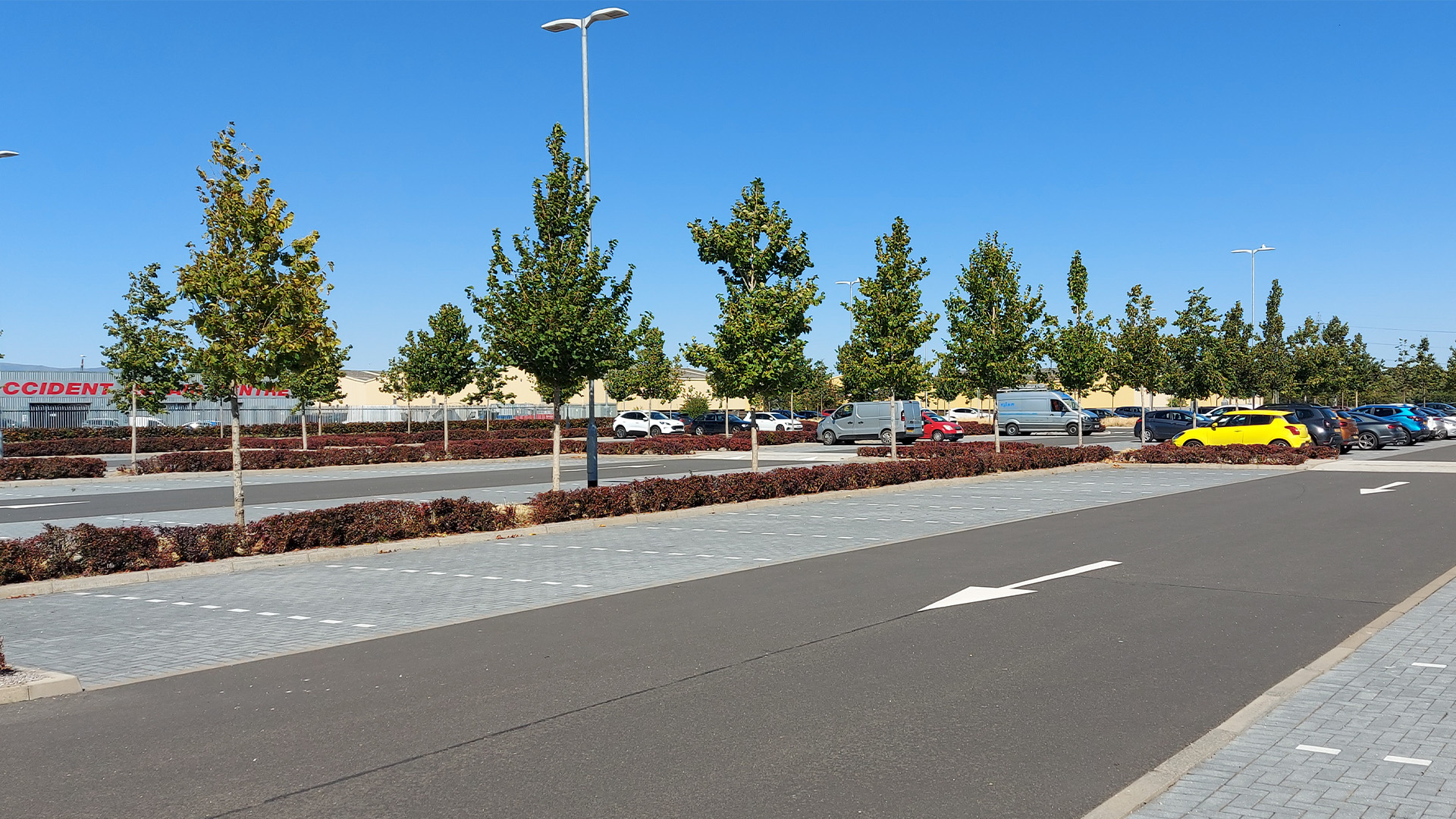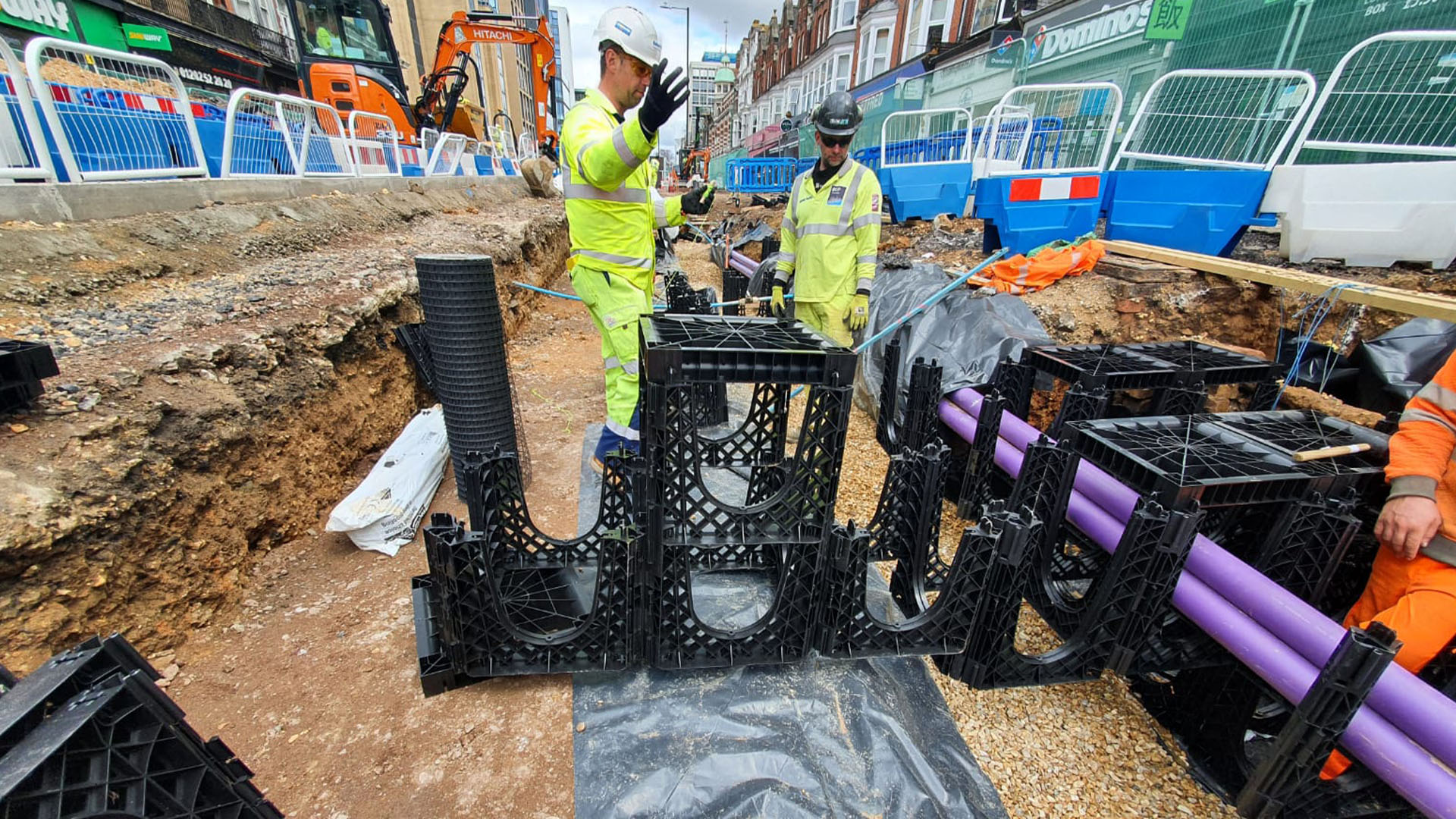Urban trees are widely acknowledged as difference-making infrastructure; vital for climate resilience, biodiversity, public wellbeing and placemaking, and also potentially a useful element in expediting a smoother planning process. Yet their inclusion in new developments still remains fraught. Despite mounting evidence of their ecological and social value, trees – in particular those located in or near the public realm – are sometimes viewed more as liabilities than assets.
But it’s not the trees that are the problem. It’s actually more when, and how, they’re considered when planning a development.
The maintenance dilemma
One of the key challenges is infrastructure acceptance, or rather the potential lack of it. Many local DOTs and public works departments, constrained by diminishing budgets and a growing burden of legacy infrastructure, have taken the decision not to accept maintenance responsibility for street trees. Or even, in some cases, any form of green infrastructure at all. The result is a default position of ‘no’ which, too often, brings design conversations to a standstill before they’ve even really begun.
With no public maintenance route available, developers are left with limited options. Trees are pushed onto private lots, or removed altogether from plans. Maintenance responsibility typically falls to a homeowners association (HOA) or special tax district – and ultimately, the homeowner – creating what is, in effect, a hidden green infrastructure fee. The idea of communal green space becomes fragmented. And the tree, once symbolic of a community-oriented and climate-conscious project, becomes a cost to either be absorbed or avoided.
What makes this even more challenging is the inconsistency between areas. One municipality may refuse outright to consider taking maintenance responsibility for any street tree, while an adjacent jurisdiction might take a more permissive approach – provided certain technical specifications are met. This inconsistency makes it difficult for developers to plan with certainty, and near impossible to replicate best practice at scale.

Mitigating tree failure
Even when trees are included, success is far from guaranteed. All too often, species are poorly suited to their environment. Soil volumes are inadequate, tree pits are installed late and to a limited specification, utility layouts leave insufficient space for roots to establish. Ongoing maintenance, where planned at all, may be minimal. And while these trees might technically fulfill a permit condition, they’re rarely afforded the opportunity to thrive – The Tree Council quotes a 47% survival rate for trees, when traditional planting techniques (in natural soil) are used.
Consider a typical scenario. A residential street is planted with small, ornamental trees – the type that look promising in renderings. But they’ve been installed into compacted sub-base with no irrigation, no meaningful soil volume, and little thought to subsurface competition. By year three, at least half are struggling or have already failed – leaving residents with sticks in the ground and unmet expectations. This reinforces the idea that street trees simply don’t work.
This theoretical yet familiar scenario is backed up by data, too. A 2024 survey by researchers at the University of Sheffield examined nearly 6,000 new homes across 42 developments in England, and found that only 53% of the legally mandated ecological enhancements – such as newly planted trees, bird boxes, ponds, and hedgerows – had been delivered as stipulated in the planning permits. Notably, 39% of the specified trees were either missing or dead.
But the real issue isn’t the trees themselves. It’s the conditions we place them in – and the point at which we start thinking about them.
Rethinking responsibility and risk
The solution doesn’t lie solely in better maintenance – though that of course has its place – but in better design, introduced at the right moment in the process. Green infrastructure must become part of the foundational design conversation, alongside drainage, transport, utilities and other core services. It must be treated as infrastructure – not an aesthetic overlay, and certainly not a last-minute compliance fix.
Crucially, this isn’t about giving landscape architects a louder voice in the room, important though that is. It’s about recognizing that trees and their associated systems perform essential, measurable functions. Properly specified and supported, urban trees contribute to environmental mitigation requirements, manage stormwater, reduce flood risk, improve air quality, mitigate urban heat, and enhance social cohesion. They’re not just decorative, they’re operational.
The long-term impact of undervaluing green infrastructure is already evident. Recent economic research revealed that neighborhoods dominated by post-2000 housing developments are served by parks that are, on average, 40% smaller than those in 1930s-built neighborhoods. This decline in accessible green space translates to millions fewer park visits each year – a clear sign that when green infrastructure is overlooked, the social and environmental consequences ripple outward for decades.
But like any element of infrastructure, they can only deliver these benefits if designed and integrated with intention – from the outset, and in coordination with the broader site strategy.

Flexibility through early engagement
When green infrastructure is embedded in early-stage thinking, it opens up creative and pragmatic design opportunities. Street trees no longer need to be confined to narrow verges or regimented roadside lines, as you might conventionally expect to see. They can become part of focal points, pocket parks, green corridors or urban stormwater management systems. Early engagement makes it easier to coordinate root zones with utilities, choose species that are locally appropriate, and design soil volumes and pit structures that will support long-term health.
For example, imagine if an early collaboration between a utilities engineer, a landscape architect and a green infrastructure specialist led to a subtle realignment of a pedestrian path within a new housing development. This single adjustment might well create sufficient subsurface volume to support a more resilient, longer-lived tree species – one capable of playing a genuine role in water attenuation and shading. It’s a small change, but one that would have been impossible if considered post-approval or during the civil engineering phase.
These kinds of solutions are commonly applicable – but they do rely on the right conversations happening early enough to influence the design.
A different kind of expertise
At GreenBlue Urban, we’re often brought in at the margins. We’re asked to troubleshoot tree failure, or to help retrofit resilience into a project already compromised by sub-optimal design choices. But the value we bring is most fully realized when we’re part of the early-stage team, working with transportation engineers, civil engineers, planners and landscape architects to co-develop workable, site-specific, code-compliant strategies.
We understand the pressures that developers face. We know what public works departments are up against. And we recognize that no one party can solve this alone – it takes informed, cross-disciplinary collaboration. When that happens, not only do trees succeed, but projects do too – functionally, environmentally and commercially.

From obligation to opportunity
The pressures on development – and the expectations of zoning regulations, planners and communities – are shifting fast. Environmental mitigation is increasingly a legal requirement. Resilience to climate change is front and center in comprehensive plans. Communities are more vocal than ever about the need for meaningful, accessible green space, and home buyers are increasingly looking for properties that offer more than just square footage. They want places that feel considered, connected, and livable.
Against this backdrop, developments that exclude trees are starting to look like missed opportunities. This isn’t just about permit approval. It’s about future-proofing value, fulfilling environmental obligations in a sincere way, and creating places in which people genuinely want to live.
We routinely support developers, planners and design teams in bridging the gap between ambition and implementation – helping to resolve the kinds of technical, regulatory and maintenance challenges that can otherwise stall or compromise green infrastructure. Whether the issue is tree placement, root zone design, maintenance agreements, or utility conflicts, we can help shape pragmatic, code-aligned strategies from the outset.
So, if your instinct is to see street trees as a complication, just pause. The complication doesn’t lie in the trees themselves, it lies in waiting too long to include them. Bring green infrastructure to the table early, and you’ll find that, far from being a liability, urban trees can become one of the most enduring and effective assets in your development toolkit.
Our team regularly supports developers and planners in shaping pragmatic, code-aligned green infrastructure strategies for improved long-term value.
